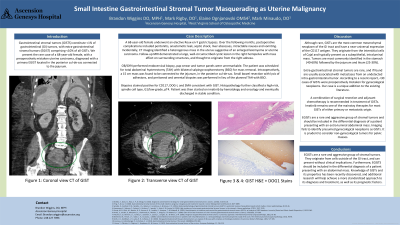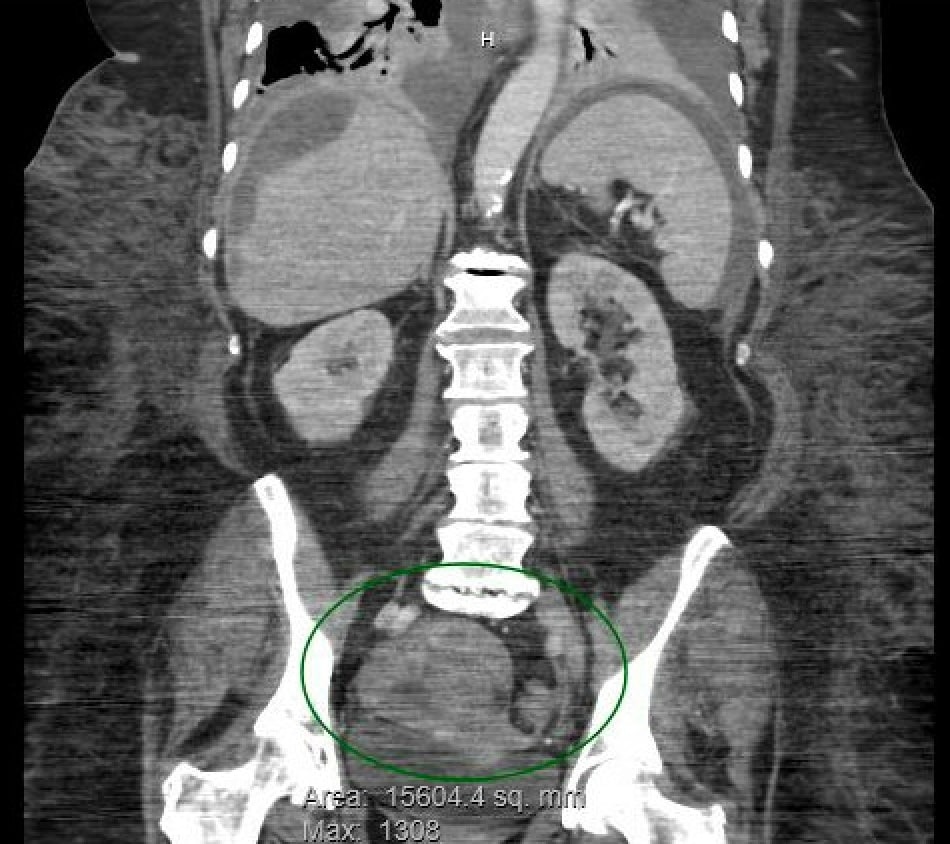Sunday Poster Session
Category: Small Intestine
P1541 - Small Intestine Gastrointestinal Stromal Tumor Masquerading as Uterine Malignancy
Sunday, October 27, 2024
3:30 PM - 7:00 PM ET
Location: Exhibit Hall E

Has Audio

Brandon T. Wiggins, DO, MPH
Ascension Genesys Hospital
Grand Blanc, MI
Presenting Author(s)
Brandon T. Wiggins, DO, MPH1, Mark Rigby, DO2, Elaine Ognjanovski, DO3, Mark Minaudo, DO1
1Ascension Genesys Hospital, Grand Blanc, MI; 2Ascension Genesys, Grand Blanc, MI; 3Ascension Macomb-Oakland Hospital, Washington, MI
Introduction:
Gastrointestinal stromal tumors (GISTS) constitute < 1% of gastrointestinal (GI) tumors, with extra-gastrointestinal stromal tumors (EGIST) comprising < 10% of all GISTs. We present the rare case of a 68-year-old female, with a preoperatively mistaken uterine carcinoma, diagnosed as a primary EGIST located in the posterior cul-de-sac connected to the jejunum.
Case Description/Methods:
A 68-year-old female underwent an elective Roux-en-Y gastric bypass. Over the following months, postoperative complications included peritonitis, anastomotic leak, septic shock, and liver abscesses. Incidentally, CT imaging identified a heterogenous mass in the uterus suggestive of uterine malignancy. Follow-up MRI demonstrated a large, well-circumscribed cystic lesion in the right hemipelvis with mass effect on surrounding structures, and thought to originate from the right adnexa.
OB/GYN performed endocervical biopsy, pap smear and tumor panels that were unremarkable. The patient was taken for abdominal hysterectomy (TAH) with bilateral salpingo-oophorectomy (BSO) for mass removal. Intraoperatively, a 15 cm mass was found to be connected to the jejunum. Small bowel resection with biopsies was performed in lieu of the planned TAH with BSO.
Biopsies stained positive for CD117, DOG-I, and SMA consistent with GIST. Histopathology further classified a high-risk, spindle cell type. The patient was then started on imatinib by hematology and oncology and eventually discharged in stable condition.
Discussion:
Although rare, GISTs are the most common mesenchymal neoplasm of the GI tract and have a near-universal expression of the CD117 antigen. They originate from the interstitial cells of Cajal and typically present as a subepithelial, intraluminal mass. Tumors are most commonly identified in the stomach (40-60%) followed by the ileum (25-30%).
Extra-gastrointestinal stromal tumors are rare, and if found are usually associated with metastases from an undetected intra-gastrointestinal tumor. According to a recent report, GISTs are rarely mistaken for gynecologic malignancy.
A combination of resection and chemotherapy is recommended in treatment of GISTs. Imatinib remains a mainstay for therapy of most GISTs.
EGISTs are a rare and aggressive group of stromal tumors and should be included in the differential diagnosis of a patient presenting with an extra-luminal abdominal mass. Imaging fails to identify presumed gynecological neoplasms as GISTs. It is prudent to consider non-gynecological tumors for pelvic masses.

Disclosures:
Brandon T. Wiggins, DO, MPH1, Mark Rigby, DO2, Elaine Ognjanovski, DO3, Mark Minaudo, DO1. P1541 - Small Intestine Gastrointestinal Stromal Tumor Masquerading as Uterine Malignancy, ACG 2024 Annual Scientific Meeting Abstracts. Philadelphia, PA: American College of Gastroenterology.
1Ascension Genesys Hospital, Grand Blanc, MI; 2Ascension Genesys, Grand Blanc, MI; 3Ascension Macomb-Oakland Hospital, Washington, MI
Introduction:
Gastrointestinal stromal tumors (GISTS) constitute < 1% of gastrointestinal (GI) tumors, with extra-gastrointestinal stromal tumors (EGIST) comprising < 10% of all GISTs. We present the rare case of a 68-year-old female, with a preoperatively mistaken uterine carcinoma, diagnosed as a primary EGIST located in the posterior cul-de-sac connected to the jejunum.
Case Description/Methods:
A 68-year-old female underwent an elective Roux-en-Y gastric bypass. Over the following months, postoperative complications included peritonitis, anastomotic leak, septic shock, and liver abscesses. Incidentally, CT imaging identified a heterogenous mass in the uterus suggestive of uterine malignancy. Follow-up MRI demonstrated a large, well-circumscribed cystic lesion in the right hemipelvis with mass effect on surrounding structures, and thought to originate from the right adnexa.
OB/GYN performed endocervical biopsy, pap smear and tumor panels that were unremarkable. The patient was taken for abdominal hysterectomy (TAH) with bilateral salpingo-oophorectomy (BSO) for mass removal. Intraoperatively, a 15 cm mass was found to be connected to the jejunum. Small bowel resection with biopsies was performed in lieu of the planned TAH with BSO.
Biopsies stained positive for CD117, DOG-I, and SMA consistent with GIST. Histopathology further classified a high-risk, spindle cell type. The patient was then started on imatinib by hematology and oncology and eventually discharged in stable condition.
Discussion:
Although rare, GISTs are the most common mesenchymal neoplasm of the GI tract and have a near-universal expression of the CD117 antigen. They originate from the interstitial cells of Cajal and typically present as a subepithelial, intraluminal mass. Tumors are most commonly identified in the stomach (40-60%) followed by the ileum (25-30%).
Extra-gastrointestinal stromal tumors are rare, and if found are usually associated with metastases from an undetected intra-gastrointestinal tumor. According to a recent report, GISTs are rarely mistaken for gynecologic malignancy.
A combination of resection and chemotherapy is recommended in treatment of GISTs. Imatinib remains a mainstay for therapy of most GISTs.
EGISTs are a rare and aggressive group of stromal tumors and should be included in the differential diagnosis of a patient presenting with an extra-luminal abdominal mass. Imaging fails to identify presumed gynecological neoplasms as GISTs. It is prudent to consider non-gynecological tumors for pelvic masses.

Figure: Computed Tomography Coronal View of Small Intestine GIST Attached to Uterus
Disclosures:
Brandon Wiggins indicated no relevant financial relationships.
Mark Rigby indicated no relevant financial relationships.
Elaine Ognjanovski indicated no relevant financial relationships.
Mark Minaudo indicated no relevant financial relationships.
Brandon T. Wiggins, DO, MPH1, Mark Rigby, DO2, Elaine Ognjanovski, DO3, Mark Minaudo, DO1. P1541 - Small Intestine Gastrointestinal Stromal Tumor Masquerading as Uterine Malignancy, ACG 2024 Annual Scientific Meeting Abstracts. Philadelphia, PA: American College of Gastroenterology.
